
Livorno is a port city on the Ligurian Sea on the western coast of the Tuscany region, Italy. It is the capital of the Province of Livorno, having a population of 158,493 residents in December 2017. It is traditionally known in English as Leghorn.

The Diana, Princess of Wales Memorial Fountain is a memorial in London dedicated to Diana, Princess of Wales, who died in a car crash in 1997. It was designed to express Diana's spirit and love of children.

Piazza del Campo is the main public space of the historic center of Siena, a city in Tuscany, Italy, and the campo regarded as one of Europe's greatest medieval squares. It is renowned worldwide for its beauty and architectural integrity. The Palazzo Pubblico and its Torre del Mangia, as well as various palazzi signorili surround the shell-shaped piazza. At the northwest edge is the Fonte Gaia.
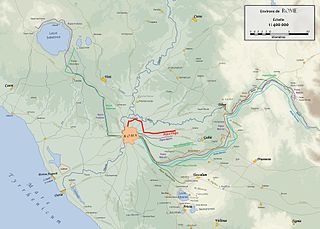
The Aqua Virgo was one of the eleven Roman aqueducts that supplied the city of ancient Rome. It was completed in 19 BC by Marcus Agrippa, during the reign of the emperor Augustus and was built mainly to supply the contemporaneous Baths of Agrippa in the Campus Martius.
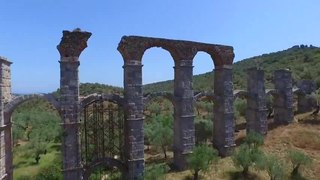
The Romans constructed aqueducts throughout their Republic and later Empire, to bring water from outside sources into cities and towns. Aqueduct water supplied public baths, latrines, fountains, and private households; it also supported mining operations, milling, farms, and gardens.
The gardens of the rotonda is a terraced garden, situated close to the historical centre of Padua, behind the sixteenth century wall and the Rampart of the Cat.
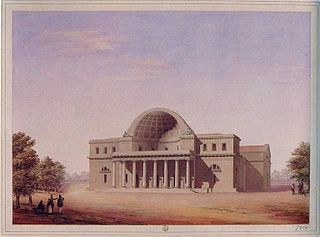
The Cisternoni of Livorno are a series of three large buildings in the neoclassical style at Livorno, in Tuscany, Italy. They were constructed between 1829 and 1848 as part of a complex of purification plants and storage tanks to the Leopoldino aqueduct; a fourth cisternone planned at Castellaccia was never built. The cisternoni, literally "great cisterns", provided Livorno — a city that is still today one of the principal ports of the Mediterranean — with fresh and, more importantly, clean water throughout the 19th and 20th centuries.
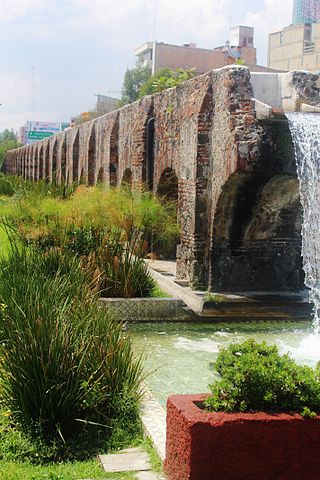
The Chapultepec aqueduct was built to provide potable water to Tenochtitlan, now known as Mexico City. Tenochtitlan was the capital of the Triple Aztec Alliance empire. This fresh water was transported from the Chapultepec springs. Two aqueducts following the same route from the springs were built by the Aztecs during the 15th century, the first destroyed by flooding and the second by the Spanish. After the Spanish conquest a colonial aqueduct was built, the ruins of which are located near Metro Sevilla.

The Palais Longchamp is a monument in the 4th arrondissement of Marseille, France. It houses the Musée des beaux-arts and Muséum d'histoire naturelle de Marseille. The surrounding Longchamp Park is listed by the French Ministry of Culture as one of the Notable Gardens of France.

The Shrine of Our Lady of Grace, also known as Sanctuary of Montenero, is a religious complex in Monte Nero, a village in Livorno Hills, near Livorno, central Italy reachable by a funicular.
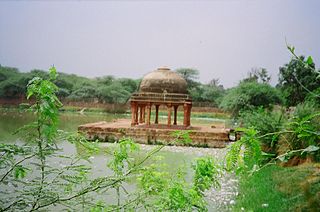
Hauz-i-Shamsi, also called Shamshi Talab, is a water storage reservoir or tank built by Iltutmish of the Slave Dynasty in 1230 CE, at a location revealed to him in a dream by the Islamic prophet Muhammad. A palace called the Jahaz Mahal was built on the eastern edge of the same reservoir during the Lodi dynasty period in the 16th century as a retreat or Inn for use by pilgrims. Also at the edge of Hauz is the tomb of 17th-century Persian writer in the Mughal court, Abdul-Haqq Dehlavi. The monuments are situated in Mehrauli, Delhi.

The Fontana delle Tartarughe is a fountain of the late Italian Renaissance, located in Piazza Mattei, in the Sant'Angelo district of Rome, Italy. It was built between 1580 and 1588 by the architect Giacomo della Porta and the sculptor Taddeo Landini. The bronze turtles around the upper basin, usually attributed either to Gian Lorenzo Bernini or Andrea Sacchi, were added in either 1658 or 1659 when the fountain was restored.

The Sweetwater Dam is a dam across the Sweetwater River in San Diego County, California. It is located approximately 12 miles (19 km) east of San Diego, 9 miles (14 km) and borders Bonita to the southwest and La Presa to the northeast. The 108-foot (33 m)-high masonry arch dam impounds 960-acre (390 ha) Sweetwater Reservoir.
The archaeological area of Poggio del Molino is situated on the northern side of a headland that acts as a watershed between the beach of Rimigliano in the north, and the Gulf of Baratti in the south; to the northern border of the territory administered by the city of Piombino in the Italian Province of Livorno. The structure of Roman age spreads over a high plateau of about 20 m asl which dominates, in the west, the stretch of a sea between San Vincenzo and Elba and to the east, the metalliferous hills and plains of the Campiglia lagoon. The top of the hill is occupied by the beautiful Villa del Barone, built in 1923 by Baron Luigi De Stefano and Assunta Vanni Desideri, the daughter of Eugenio. From a paper of the 16th century, the "Bandita di Porto Baratti", and some archival documents we know that the Poggio owes its name to the mill which was a part of Torre Nuova, the building of coastal defense and a lookout built in the early sixteenth century by Cosimo I de' Medici, on the slopes of the promontory.
The Aqueduct of Nottolini is an aqueduct in Neoclassical Style near the city of Lucca, region of Tuscany, Italy. The 19th-century structure brought water to Lucca from the mountains south of the city through a stone channel supported by more than 400 arches, stretching for over 3 kilometres. It is now interrupted by the east-west autostrada A11 from Florence to Pisa.
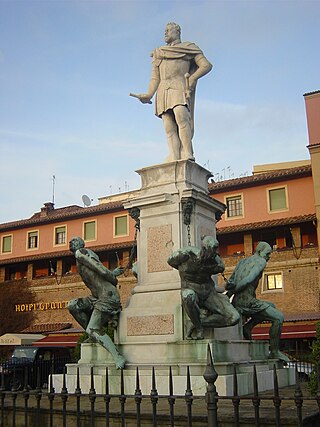
The Monument of the Four Moors is located in Livorno, Italy. It was completed in 1626 to commemorate the victories of Ferdinand I of Tuscany over the Ottomans.

A nasone, also called a fontanella, is a type of drinking fountain found in Rome, Italy. Literally meaning "large nose", they got their name from their characteristic design first introduced in the 1870s. There are approximately 2,500–2,800 nasoni in Rome, supplying people with free drinking water.

The Bottini di Siena are a complex system of medieval underground aqueducts for the water supply of the city of Siena with a total length of 25 km. The system used to be the main water supply of the entire city of Siena until 1914 and nowadays continues to supply water to the fountains of Siena.

Azienda Trasporti Livornese, known as ATL, was a public company that managed the local public transport in Livorno and its province including Elba.

Montenero is a fraction of Livorno, Tuscany, in Italy situated on the slopes of a hill and known for the Santuario della Madonna delle Grazie di Montenero.

















